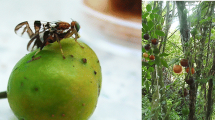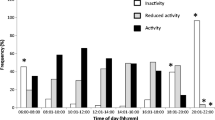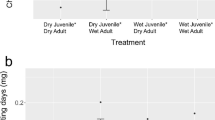Summary
The hypothesis was tested that egg-laying by rosehip fruit flies,Rhagoletis basiola, would lead to reduced adult survivorship compared with oviposition-deprived flies, through experimental manipulation. Oviposition-deprived flies were assigned to two groups: mated and spinster. All three treatment groups were permitted to spend equal time and energy exploring and handling hosts but only the former group were allowed to deposit eggs (three/day). Results clearly showed that ovipositing flies suffered significantly higher mortality rates and that mated and spinster flies produced similar survivorship patterns. I consider these results both as a foraging problem (i.e. laying eggs in inferior hosts can cost both eggs and life) and as a more general life history problem.
Similar content being viewed by others
References
Alphen, J. J. M. van, Dijken, M. J. van and Waage, J. K. (1987) A functional approach to superparasitism: host discrimination need not be learnt.Neth. J. Zool. 37, 167–79.
Bell, G. and Koufopanou, V. (1988) The cost of reproduction.IN Oxford Survey of Evolutionary Biology 5, 83–131.
Carey, J., Krainacker, D. A. and Vargas, R. (1986) Life history response of female Mediterranean fruit flies,Ceratitis capitata, to periods of host deprivation.Ent. Exp. Appl. 42, 159–67.
Charnov, E. L. and Stephens, D. W. (1988) On the evolution of host selection by solitary parasitoids.Amer. Natur. (in press).
Clutton-Brock, T. H., Guinness, E. F. and Albon, S. D. (1982)Red Deer: Behaviour and Ecology of Two Sexes. University of Chicago Press, Chicago, USA.
Fitt, G. P. (1986) The influence of shortage of hosts on the specificity of oviposition behaviour in species ofDacus (Diptera, Tephritidae).Physiol. Ent. 11, 133–43.
Green, R. F. (1984) Stopping rules for optimal foragers.Amer. Natur. 123, 30–43.
Iwasa, Y., Higashi, M. and Matsuda, H. (1984) Theory of oviposition strategies of parasitoids.Theor. Pop. Biol. 26, 205–27.
Kirkwood, T. B. L. (1981) Repair and its evolution: survival versus reproduction.Physiological Ecology: An Evolutionary Approach to Resource Use. C. R. Townsend and P. Calow (eds), pp. 165–89. Sinauer, Sunderland, USA.
Mangel, M. and Roitberg, B. D. (1989) Dynamic information and host acceptance by a tephritid fly.Ecol. Ent. (in press).
Opp, S. and Prokopy, R. J. (1986) Variation in laboratory oviposition byRhagoletis pomonella (Diptera: Tephritidae) in relation to mating status.Annals Ent. Soc. Amer. 79, 705–10.
Prokopy, R. J. and Boller, E. F. (1971) Artificial egging system for the European cherry fruit fly.J. Econ. Ent. 63, 1413–17.
Reznick, D. (1985) Costs of reproduction: an evaluation of the empirical evidence.Oikos 44, 257–67.
Roff, D. A. (1984) The evolution of life history parameters in teleosts.Canad. J. Fish. Aquatic Sci. 41, 989–1000.
Roitberg, B. D. (1985) Search dynamics in fruit-parasitic insects.J. Insect Physiol. 31, 865–72.
Vet, L. E. M. and van Opzeeland, K. (1985) Olfactory microhabitat selection inLeptopilina heterotoma (Thomson) (Hym.: Eucoilidae), a parasitoid of Drosophilidae.Neth. J. Zool. 35, 497–504.
Waage, J. K. and Godfray, H. C. J. (1985) Reproductive strategies and population ecology of insect parasitoids.Behavioural Ecology: Ecological Consequences of Adaptive Behaviour. R. M. Sibly and R. H. Smith (eds), pp. 449–70. Blackwell Scientific, Oxford, UK.
Webster, R. P., Stoffolano, J. G. and Prokopy, R. J. (1979) Long-term intake of protein and sucrose in relation to reproductive behaviour of wild and laboratory culturedRhagoletis pomonella.Annals Ent. Soc. Amer. 72, 41–6.
Zar, J. H. (1984)Biostatistical Analysis. Prentice-Hall, NJ, USA.
Author information
Authors and Affiliations
Rights and permissions
About this article
Cite this article
Roitberg, B.D. The cost of reproduction in rosehip flies,Rhagoletis basiola: Eggs are time. Evol Ecol 3, 183–188 (1989). https://doi.org/10.1007/BF02270920
Issue Date:
DOI: https://doi.org/10.1007/BF02270920




